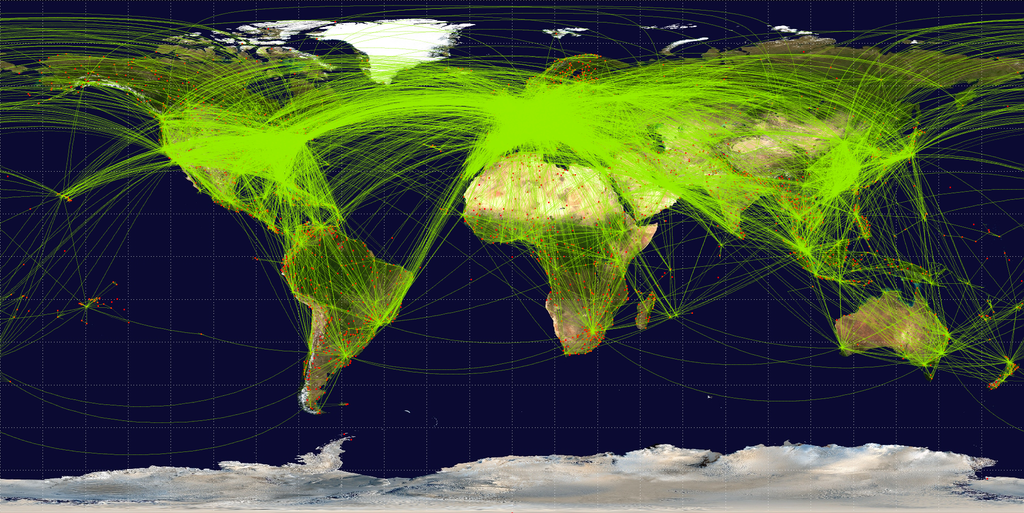Estimated reading time 12 minutes, 50 seconds.
Recently, I visited our nation’s capital, Ottawa, and all over the city there were signs saying, “The world needs more Canada.” In my opinion, “Canada needs more of the world” as well.

In the 2019 report on the future of the Canadian aerospace industry, “Vision 2025: Charting a New Course,” championed by Jean Charest, there is a statement that Canada is the fifth largest aerospace nation. In my role as a global commerce development expert, I’ve spoken with many who believe Canada is actually third.
That sounds reassuring and comfortable, but is it really true? Enormous global changes have happened in the past 12 years since 2008. In some ways, it seems we are failing to see that the biggest change of all is upon the world and our industry.
There are four disruptive forces that have been changing the way we live and work: the age of urbanization; accelerating technological change; challenges of an aging world; and globalization and greater global connections.
I am concerned we are falling into a familiar old trap called complacency. In the 2018 report, “Global Aerospace Industry: Size & Country Rankings,” compiled by respected industry analyst Richard Aboulafia of The Teal Group and aerospace consultant Kevin Michaels from AeroDynamic Advisory, Canada is actually listed as No. 7 on the list of the world’s top aerospace nations.
Are you shocked by that ranking? I have lived and worked on three continents, in five countries and in nine cities. I have worked with leading organizations from all over the world, specializing in aerospace for 20 years. I am also a frequent international business traveller. Based on my experience, I would believe that seventh place is the bitter — but more realistic — ranking.
I have found the following to be one of the biggest paradoxes for Canada: Canada is proud to call itself a trading nation. It is one of the world’s most multicultural countries. Yet, we seem to voluntary lock ourselves in … as if Canada is a prison. We live below our potential with only very few companies embracing international trade. Shockingly, just “2.8 per cent of the Canadian business population traded goods with foreign markets in 2018,” according to a Statistics Canada report published in May 2019.
Companies have vast untapped export potential, especially smaller ones. Why ignore that Europe is a market approximately two times bigger than the U.S.? How about Asia, where two thirds of the world’s population lives, with an emerging middle class that has increasing needs and disposable income?
The reality is that more and more companies who have been leaders in their home market for decades are starting to be challenged by competitors from far and wide. For aerospace, this is especially true, as it is for the automotive and technology industries.
Let’s be honest and say it like it is: Your company must develop “go global muscle” not just to survive, but also to thrive. Moreover, you can and should go global in 365 days. Why? Because you cannot afford to fall behind and you should move quickly. One year is enough to see the initial results of your international efforts. Have a purpose, stay focused every day, and commit to winning your first customer or partner in a new market within 365 days. Remember, it is not about perfection: it is about progress. Progress every day!
Plan and prepare
To find international business success, it’s necessary to create your plan, prepare for its implementation, and then follow it step-by-step every day.
I cannot emphasize enough the critical importance of thinking and then acting. Just as pilots plan each flight while still being prepared to make adjustments along the way, businesses must know where they want to go and be flexible as they embark upon the journey.
An international trade plan should include 12 key ingredients:
- Customer
- Value Proposition
- (Bene)fits [In order to provide benefits, you need the perfect fit. This is why I call it “(bene)fits.”]
- Risks
- Journeys
- Activities
- Resources
- Partners
- Sales
- Marketing
- Revenue
- Cost

Here are some specific points Canadian organizations should consider when Going Global:
1. Diversify now. If we look at the Canadian economy and at our aerospace industry in particular, as a company we would be horrified to discover that we have only one customer. We all know who that is. Seventy-five per cent of Canada’s exports are to the U.S., and eighty per cent of Canadian aerospace exports head south of the border. Even worse for Canada is that the U.S. does not need Canada — period. It has a number of internal resources and at least two other supplier countries besides Canada. This puts us at high risk. For Canada’s sake and future, this has to change. Canada must look beyond the U.S. — for example, towards Europe and Asia, and diversify quickly.
2. Canada as a brand. Tuscany, Italy, gave Europe and the world its first public library, founded the first banks and commissioned the first opera. Chianti was the world’s first officially defined wine-producing region – the logo for Gallo Nero wines, the black rooster, dates from the 14th century, so is arguably the world’s first “brand.” We Canadians are lucky. We are well liked and we have a good reputation. However, we seem to be somewhat timid to leverage Canada’s brand in business. We should.
3. Sale, sale, sale! Mathew Evans and Henry Woodward, both Canadians, developed and patented an incandescent light bulb on July 24, 1874, five years before Thomas Alva Edison’s U.S. patent on the device. But, they did not develop and promote their invention, so they sold their U.S. patent to Thomas Edison for US$5,000. The rest, as they say, is history. But the fact is, all the economic value of the invention is not in Canada. We have great inventors, including Joseph-Armand Bombardier, Mike Lazaridis and Jim Balsillie, and Sir Sandford Fleming. Also, Canada invests heavily in R&D, yet we absolutely must improve our commercialization skills. Why not implement sales courses in our schools, colleges and at work? The aerospace industry is one of the most R&D intensive industries, yet too many R&D projects are still too detached from the real world. They are hidden somewhere in a basement without ever seeing the light of implementation. I would like to introduce a new term: R&D Commercialization, because simple R&D is not good enough anymore. We should adapt commercialization best practices if we wish to survive in the age of disruption. Any company should consider itself as a start-up and begin and end with the client at heart.
4. Attract, train and retain the world’s best talent. Our aging population is a fact; most aerospace industry professionals are in their 50s or above. Attracting talent is a challenge. Kindling a passion for flight among young people proves to be difficult, as there are many temptations and strong competition from other industries, including the tech sector. Retention is too often overlooked. I cannot sugarcoat this: Industry is doing a poor job of retaining those who selected aerospace as career choice. To address these challenges, we can start by encouraging older employees who wish to continue working to do so, and for those who wish to leave, we can keep the door open if they want to return. We must create a more engaging environment where the transfer of knowledge and open communication is encouraged and appreciated. Attracting young people is a must, and role models must be retained to relight the passion for aerospace! Retention is too often overlooked, and my most urgent call for action is the retention of talent. Consider implementing continuous integration over a longer period of time versus the usual three months of on-boarding. Furthermore, we must adapt new technologies to keep us productive and a lively new culture for all generations that includes competitive compensation. More and more professionals are looking for truly meaningful work with purpose. Continuous learning is for both companies and employees. Talent today has many shapes and forms and is not what it used to be. In the aerospace industry, we service a very diverse population from all corners of the world. It is time for aerospace to become more global like its customers.
5. Confidence and moving up the value chain. I would like to conclude with the following open question: Why don’t we have a Canadian car? Similarly, why don’t we have more and bigger Canadian companies to champion and commercialize our century-plus of experience in civil aircraft, engines, avionics and electronics, landing gear, simulators, robotics and automation, space and satellites, and even shims? We all proudly celebrate American, European, and Japanese organizations in Canada. For example, 14 of the top 25 global aerospace companies have operations in Ontario. But we should also celebrate Canadian companies and successes such as Heroux Devtek and Shimco! Toronto is the landing gear capital of the world, with UTC Systems, Safran and Japan’s SPP Canada Aircraft Inc., in addition to Heroux Devtek. Ontario provides landing gear for 75 per cent of Boeing and Airbus commercial aircraft programs. Yet, too often, this is not advertised and comes as a surprise.
I believe we should be more confident in our abilities, knowledge and know-how, so we can move up the value chain. This is the right response to the overall industry trend of consolidation. Also, it will make us more globally competitive. Canada must grow and scale bigger companies, including in aerospace. There are over 700 aerospace companies in Canada, but an overwhelming 93 per cent are small-to-medium enterprises.
There are opportunities within our reach. We must think globally, be up to date with world trends, and bring back events such as the Aerospace Market Outlook Seminar, previously hosted by the Ontario Ministry of Economic Development, Job Creation and Trade.
The world needs more Canada, but Canada also needs more of the world.

Reneta Johnson is the founder and CEO of Inttradia Inc. and author of the upcoming book Go Global in 365 Days. She is an expert in global commerce development and uses her own unique business methodology, an industry leading executive network and personal experience to unlock business potential and help clients realize international business success.








